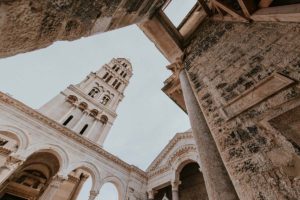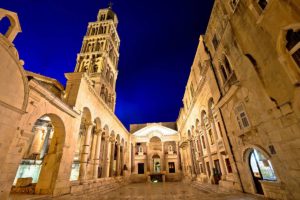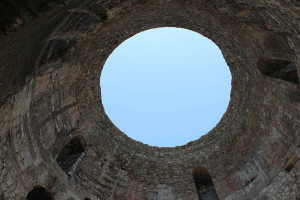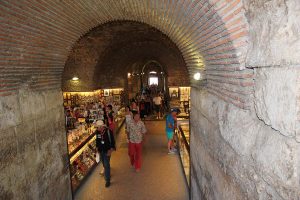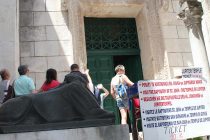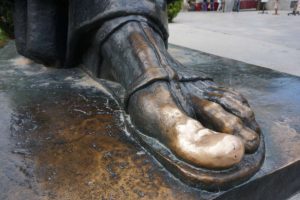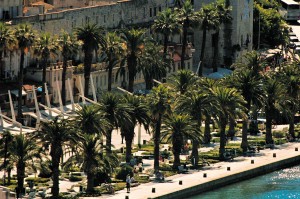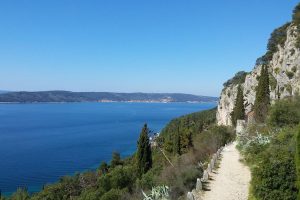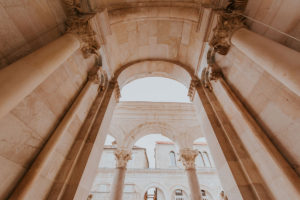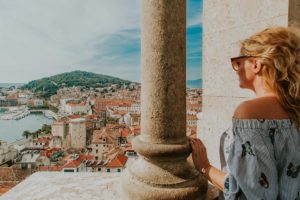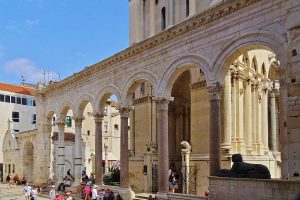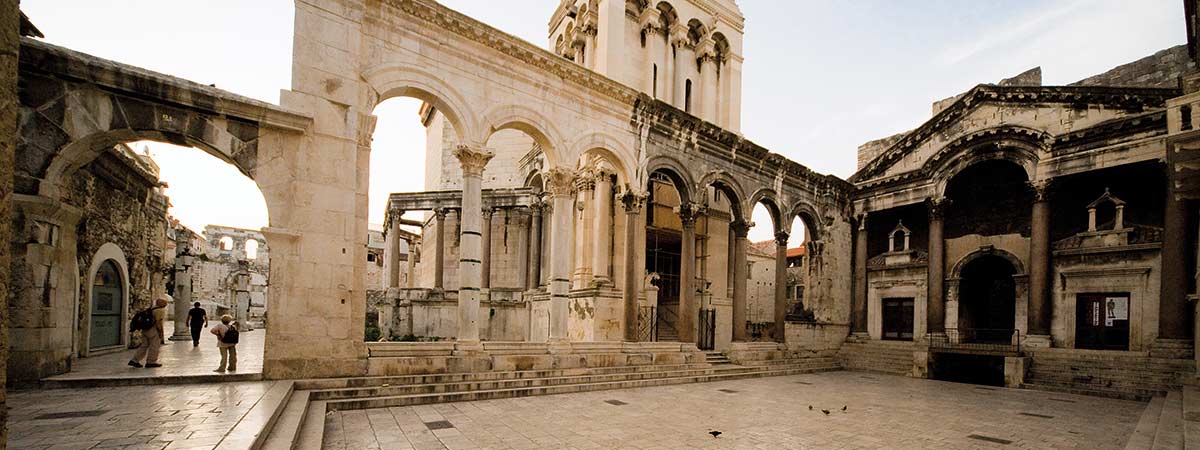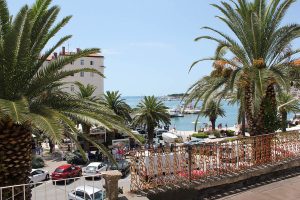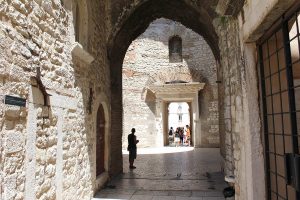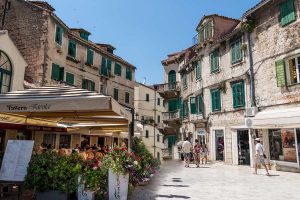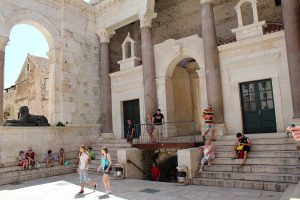
History of the Palace
A closer look at Croatia’s second largest city reveals a very unusual and unique scene- here, life goes on in an ancient Roman palace that has been standing here for almost 1700 years.
Why is it unusual? Because by definition- ruins are neglected and abandoned structures, but here in Split, the old palace bursts with life.
Diocletian’s palace, the UNESCO Heritage Site since 1979, is the living heart of Split!
This is very interesting because right here is the exact place where the city was born.
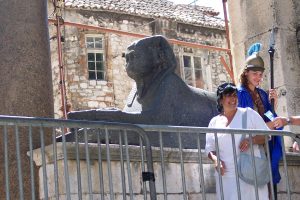
On the Adriatic side, the walls were 22 meters high and 2 meters thick. Only 3 towers remained of 16 and 4 gates: Porta Aurea (Golden Gate) on the north, Porta Argentea (Silver Gate) on the east, Porta Ferrea (Iron Gate) on the west, and Porta Aenea (Bronze Gate) on the south.
The whole complex occupied around 30,000 square meters and the whole palace was built from local white stone, limestone and imported white marble.
The design of the palace is a mix of villa and castrum architecture and the Emperor’s apartments were located on the southern part of the complex – along the seaside.
The Golden Gate (Porta Aurea) was the main entrance to the palace which the emperor used when he entered his new home for the first time in June, 305 AD, after his abdication.
Emperor Diocletian is the only Roman emperor ever who voluntarily gave up the throne of the Roman Empire, in the turn of the 4th century, built the palace and after his retirement in 305 settled here on the beach, in the Illyrian province of Rome.
Diocletian’s Palace on Instagram
[ess_grid alias=”Diocletian-Palace”]
Only the substructures and lower floors of Diocletian’s apartments have survived to our days. Diocletian’s octagonal mausoleum, which later was reconstructed into a Christian cathedral of Saint Domnius which is one of the oldest in the world. Three temples were also located in the southern part of the palace, but one of the temples was later turned into a baptistery, the other two were destroyed.
We have also the remains of outer walls and gates, as well as three of the 13 Egyptian sphinxes which Diocletian had used to decorate the palace and the rest of the old city is covered with white stone buildings from different periods and styles.
Must See Sights
Cathedral
Today, the most prominent of the Diocletian’s Palace sights is the Cathedral of St. Domnius. Originally built as Diocletian’s mausoleum, it sits in the center of the Palace on the main square, Peristil. The elaborate main altar is in the center of the room, where Diocletian’s Tomb once was. A few original columns are all that is left from the original interior. There are altars on both sides of the main altar, with relics of St Domnius and St Anastasius, martyrs executed in the nearby Solin, take an honorary place. In the middle stood the Diocletian’s sarcophagus which was later destroyed. Above the niches rise eight red granite Corinthian pillars, and right above them another eight smaller ones. Two medallions with bows are specially interesting as the archaeologists and Split’s tradition recognize in them the portraits of Emperor Diocletian and his wife Prisca. The cornice circling above shows a relief of erots hunting, masks and human heads.
The Split Cathedral was converted to a church after the fall of Rome and the bell tower was added in the 13th century and then completely renovated at the end of the 19th century.
Usually it is open for the visitor to climb to the top, but after being restored a little bit more than a hundred years ago, one of the main symbols of the city will again be refined from this year and it will take approximately three years till its finish, so keep tuned!
Peristil
At the heart of the palace is the Peristil, a monumental courtyard where the Emperor used to entertain his guests. Situated on the crossroad of the two main roads of the palace, Peristil is a rectangular open court decorated with colonnade which was the heart of the palace, where the most powerful Roman citizens were gathering. Peristyle as the central square of the Palace, also located in the part where several temples were built, was intended for Emperor Diocletian- celebrated as the living son of Jupiter. The emperor appeared under the arch of the central part of the protirone, the subjects approached him, kneeling, kissing his scarlet cloak, or falling down in front of him, lying with the whole body on the ground. The red color of granite columns emphasizes the ceremonial function. Namely, from the times of Emperor Diocletian- purple becomes the color of the emperor.
Peristyle on Instagram
[ess_grid alias=”Peristyle”]
Thanks to its unique beauty and unusual acoustics, Peristil has become an ideal stage scene, ideal for opera classics or works of ancient literature, but also the stage where rich urban life takes its place. Having coffee on the stairs around Peristyle is a unique experience, one of the closest touches of a contemporary man with antique heritage, not only Roman but also Egyptian, as over 3500 years old and splendidly preserved sphinx witnesses the amazing history of Split.
That is why Pope John Paul II was impressed and said: ‘Dear God, how many feet have stepped through here’. That is why Split residents consider Peristil the center of Split and- the whole world!
Vestibul
Right from the Peristil you will enter Vestibule whose structure is rectangular from the outside and circular from the inside, what makes it truly unique in the world.
Vestibule was the entrance to the residential part of the palace- only for selected audience, where the visitors were prepared for meeting the ruler, ‘the one above them’ and this is also one of the reasons why it was so impressive.
Vestibule on Instagram
[ess_grid alias=”vestibule”]
When you are inside, you will inevitably feel the grandeur of the vestibule. Thoroughly laid stones and Roman bricks go up and up, but without the ceiling. Today, there is an opening through which you can see the sky, but there used to be a magnificent dome. It is not known when it collapsed or what caused this unfortunate event.
There is an entrance from the Etnohraphic museum to the terrace on the top of the Vestibul with some 60 stairs worth of climbing because the sight from this view point, on Split old center and the Cathedral in its full scale, is simply spectacular.
Substructures
Archaeologists have been digging through the Diocletian’s Palace underground for the past 50 years and the contents of the well-preserved palace basement have helped in piecing together information about the palace history.
The palace was built on land that sloped to the sea and the basement was built to support and level the upper floors of the palace. The substructure rooms show an exact floor plan of the original residential area of the palace, which has been long gone.
Diocletian Palace Basement Halls on Instagram
[ess_grid alias=”Basements”]
After the fall of Rome, the palace was left to ruins. It was again inhabited in 641 by citizens seeking protection from the Slavs. As the residents moved in, they tossed their rubbish in the basement what helped to keep them intact. Recent excavations have found evidence of both temporary and permanent housing structures from the 6th and 7th centuries, as well as water wells and an olive oil press from early medieval times. Walking through the vast, moisture-rich rooms allowed us to imagine what the decorated upstairs might have looked like.
Today, the central hall of substructures is the main communication from Riva to Peristil and a place where it is possible to buy various, colourful souvenirs, while the rest of this Palace area is accessible for visitors by purchasing the entrance ticket.
Jupiter temple
Jupiter was the highest Roman god and considered for Diocletian’s father so the temple served to celebrate the Jupiter’s cult. After the fall of the Roman Empire, the temple was converted into Cathedral baptistery.
Inside the temple there is a statue of St John the Baptist, made by the famous sculptor Ivan Mestrovic. There are also two medieval stone coffins where the archbishops of Split- John and Luka were buried. The imposing arched ceiling has a series of face sculptures looking down at visitors.
Jupiter Temple on Instagram
[ess_grid alias=”jupiter-temple”]
On one of the plates there is a display of the Croatian King (Peter Krešimir IV or Zvonimir), which is the earliest depiction of a European king in medieval stone sculpture.
At the entrance of the temple, another Egyptian sphinx can be seen but it has been vandalized and has no longer a head. The Baptistery is open for visitors, with an entrance fee.
Grgur Ninski
Another especially visited site for tourists is the statue of Grgur Ninski, made by Ivan Mestrovic in 1929, Grgur Ninski was the arch bishop of Split in the 10th century who also strongly opposed the Pope. Services were always held in Latin which was not understandable to the people of Croatia, but Grgur Ninski changed his services into the Croatian language what created more worship among the people as they understood their services and prayers.
Gregury Nin on Instagram
[ess_grid alias=”gregury-nin”]
Along with this, the Croatian national Glagolitic script was also preserved so that both became part of our national culture. Grgur Ninski became the symbol of pride among ordinary people.
Previously, the statue was located on the square of Peristyle but was moved in World War II. Back then, it was cut into three pieces and dug underground to hide it from the occupying forces. It was returned back but outside the palace wall by the Golden gates entrance.
It is believed that touching the toe of the statue brings luck, so over the years, as so many locals and tourist visit the statue, the toe is now smooth and shiny gold.
Riva
The Riva, main promenade which is considered for city living room, started to look the way it does today two centuries ago, when in time of Napoleon, France ruled these parts through Marshal Marmont. Since then, it has been widened and reconstructed several times, but it was always blessed with the most spectacular surrounding and view. The complete south facade of the Diocletian Palace is ‘holding back’ to Riva, with the direct entrance into the Substructures, continued with the buildings that were built west of the Palace walls.
This pedestrian heaven also has a view on the Franciscan monastery with the church of St. Francis and the Port Authorities building on its east end including the view on the main city harbor.
Riva on Instagram (Split Promenade)
[ess_grid alias=”Riva-Split”]
Today this promenade is the most popular and most important public place in Split ideal for having morning or afternoon coffee since it is full of cafes and restaurants.
Also, numerous cultural and entertainment events are always being held right here on this stage of city life since Riva represents an irreplaceable urban ambient.
Don’t forget- when you are in Split, you have to take a walk across the Riva and have a cup of coffee in one of many vivid cafes, because than you will experience something that locals call ‘fjaka’- known as the sweetness of doing nothing. It is specific state of mind where time stops for you just to enjoy and in this relaxed state of mind and body all the problems are far away!
Marjan Hill
Pure harmony between natural and urban is situated on Marjan – the hill on the west side of the Split peninsula that overlooks the city and attracts the views and interest.
Marjan has always been the most impressive part of Split visual identity and the lungs of the city. From here, Split is right on your palm and you can see it whole in all its glory and splendor.
In this green oasis, you will also find many sacred monuments. You can start your walk till the oldest church on Marjan from 13th century- Saint Nicholas church, who is considered for the guardian of children, sailors, merchants, travellers, fishermen and fiancée. From here you can follow the south path (Marangunic promenade) which will reward you with spectacular view on islands and Marjan’s beaches. This direction will also lead you to three more churches from 15th century.
Marjan on Instagram
[ess_grid alias=”marjan”]
Special place on Marjan hill also has one of the best preserved Jewish cementers in Europe from 16th century. This Jewish cemetery at Marjan is today a monument of culture, but also a monument of tolerance and common life of Split and the Jewish community through the centuries. The history of the Jewish community is closely related to the history of the city, because its members shared good and bad with all the citizens of Split. The effects were two-way, and Split can boast that in difficult times for the Jews in Europe this social injustice has been brought to a minimum under the given circumstances. A monument to this great civilization achievement is this cemetery on Marjan.
The very fact that everybody can climb up to Marjan directly from Riva, waterfront of Split, gives the visitors a chance to experience the beauty of this park-forest and offers them both- peace and tranquillity, as well as recreation and entertainment.
Palace today
The ancient fortress has become the old town of Split, with numerous shops, cafes, restaurants, hotels and apartments, located in the old buildings right on narrow streets of the old Palace.
Around 3000 people live on the territory of Diocletian’s palace today and during the day you can often hear people singing in the palace, but in the evening lights, the palace is particularly attractive.
In November 1979, UNESCO declared the palace remains a World Heritage site as important archaeological complex. The inside of Diocletian’s Palace has a fantastic mix of locals and tourists and within its white stone walls there are not only vestiges of an ancient civilization, but also numerous shops, bars, cafes, hotels and houses where people still live. The Diocletian’s palace is also featured on the back side of the Croatian 500,00 kuna banknote.
Survived facade of the palace that overlooks Split waterfront, bursts with life and colors.
On the mornings, everybody sipping coffee on Riva, street singers singing, locals are passing by and the sounds of their voices float down the alleys, as Dalmatian people are pretty loud and dynamic people. The afternoons are quieter, but kids play around every corner and one can’t help but wonder how many other kids have played here over the past centuries… At night, locals and tourists can both be found at Peristil listening to amazing live music, dining in restaurants, enjoying perfect Croatian vines.
So, 1700 years after- the old Palace of great Diocletian is the living heart of Split!







